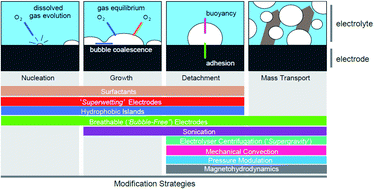The prospects of developing a highly energy-efficient water electrolyser by eliminating or mitigating bubble effects
Abstract
Highly efficient and inexpensive electrochemical splitting of water into hydrogen and oxygen gas constitutes the most critical capability needed for the development of a future hydrogen economy based on renewable energy. This work considers the prospects of developing a commercially-feasible water electrolyser with 95–100% energy efficiency (relative to the Higher Heating Value, HHV, of hydrogen) at the cells in the near future. We show that at least a 5–10% improvement in energy efficiency over the best, existing commercial water electrolysers would be needed. The elimination or mitigation of the direct and indirect energy losses arising from bubble formation in electrolysers would produce the needed energy savings. This work reviews the many strategies that have been proposed to improve the efficiency and cost of water electrolysers in that respect. Innovations in electrolyser design and engineering that seek to avoid the indirect losses are described, particularly innovations in the balance-of-plant that supports the electrolysis cells in an electrolyser. Thereafter, approaches aiming to avoid the direct energy losses are discussed, including: (1) the creation of hydrophobic locations on electrode surfaces to advantageously control where bubbles form and release, (2) the use of gas capillary actions to directly extract gas through a porous hydrophobic membrane as it is created, before bubbles form, (3) the creation of a superwetting surface morphology on electrodes to accelerate and control bubble dynamics, (4) the modification of the liquid electrolyte and its interface with the electrode surface to promote bubble formation and release, (5) sonication of the electrolyte to assist in bubble detachment and mass transport, (6) centrifuging to create a supergravity field within an electrolyser that maintains the electrodes and inter-electrode space free of bubbles, (7) rapidly pumping electrolyte over electrode surfaces to remove and separate bubbles as soon as they are formed, (8) applying continuous pressure swings to dynamically alter the buoyancy of the bubbles and thereby accelerate their release and removal; and (9) the use of magnetic fields to accelerate gas bubble detachment and transport. A combination of such an approach, coupled with innovative engineering to diminish the balance of plant, may potentially provide the improvements needed to realise truly energy-efficient, low-cost electrolysers.



 Please wait while we load your content...
Please wait while we load your content...